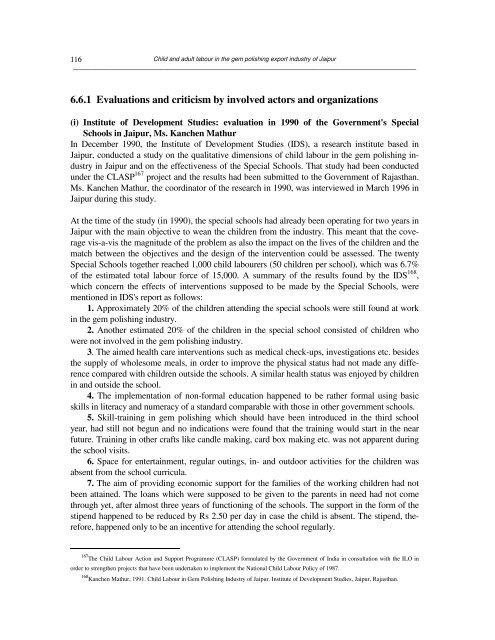You also want an ePaper? Increase the reach of your titles
YUMPU automatically turns print PDFs into web optimized ePapers that Google loves.
116<br />
<strong>Child</strong> <strong>and</strong> <strong>adult</strong> <strong>labour</strong> <strong>in</strong> <strong>the</strong> <strong>gem</strong> polish<strong>in</strong>g <strong>export</strong> <strong>in</strong>dustry <strong>of</strong> Jaipur<br />
──────────────────────────────────────────────────────────────────────────────────────────────<br />
6.6.1 Evaluations <strong>and</strong> criticism by <strong>in</strong>volved actors <strong>and</strong> organizations<br />
(i) Institute <strong>of</strong> Development Studies: evaluation <strong>in</strong> 1990 <strong>of</strong> <strong>the</strong> Government's Special<br />
Schools <strong>in</strong> Jaipur, Ms. Kanchen Mathur<br />
In December 1990, <strong>the</strong> Institute <strong>of</strong> Development Studies (IDS), a research <strong>in</strong>stitute based <strong>in</strong><br />
Jaipur, conducted a study on <strong>the</strong> qualitative dimensions <strong>of</strong> child <strong>labour</strong> <strong>in</strong> <strong>the</strong> <strong>gem</strong> polish<strong>in</strong>g <strong>in</strong>dustry<br />
<strong>in</strong> Jaipur <strong>and</strong> on <strong>the</strong> effectiveness <strong>of</strong> <strong>the</strong> Special Schools. That study had been conducted<br />
under <strong>the</strong> CLASP 167 project <strong>and</strong> <strong>the</strong> results had been submitted to <strong>the</strong> Government <strong>of</strong> Rajasthan.<br />
Ms. Kanchen Mathur, <strong>the</strong> coord<strong>in</strong>ator <strong>of</strong> <strong>the</strong> research <strong>in</strong> 1990, was <strong>in</strong>terviewed <strong>in</strong> March 1996 <strong>in</strong><br />
Jaipur dur<strong>in</strong>g this study.<br />
At <strong>the</strong> time <strong>of</strong> <strong>the</strong> study (<strong>in</strong> 1990), <strong>the</strong> special schools had already been operat<strong>in</strong>g for two years <strong>in</strong><br />
Jaipur with <strong>the</strong> ma<strong>in</strong> objective to wean <strong>the</strong> children from <strong>the</strong> <strong>in</strong>dustry. This meant that <strong>the</strong> coverage<br />
vis-a-vis <strong>the</strong> magnitude <strong>of</strong> <strong>the</strong> problem as also <strong>the</strong> impact on <strong>the</strong> lives <strong>of</strong> <strong>the</strong> children <strong>and</strong> <strong>the</strong><br />
match between <strong>the</strong> objectives <strong>and</strong> <strong>the</strong> design <strong>of</strong> <strong>the</strong> <strong>in</strong>tervention could be assessed. The twenty<br />
Special Schools toge<strong>the</strong>r reached 1,000 child <strong>labour</strong>ers (50 children per school), which was 6.7%<br />
<strong>of</strong> <strong>the</strong> estimated total <strong>labour</strong> force <strong>of</strong> 15,000. A summary <strong>of</strong> <strong>the</strong> results found by <strong>the</strong> IDS 168 ,<br />
which concern <strong>the</strong> effects <strong>of</strong> <strong>in</strong>terventions supposed to be made by <strong>the</strong> Special Schools, were<br />
mentioned <strong>in</strong> IDS's report as follows:<br />
1. Approximately 20% <strong>of</strong> <strong>the</strong> children attend<strong>in</strong>g <strong>the</strong> special schools were still found at work<br />
<strong>in</strong> <strong>the</strong> <strong>gem</strong> polish<strong>in</strong>g <strong>in</strong>dustry.<br />
2. Ano<strong>the</strong>r estimated 20% <strong>of</strong> <strong>the</strong> children <strong>in</strong> <strong>the</strong> special school consisted <strong>of</strong> children who<br />
were not <strong>in</strong>volved <strong>in</strong> <strong>the</strong> <strong>gem</strong> polish<strong>in</strong>g <strong>in</strong>dustry.<br />
3. The aimed health care <strong>in</strong>terventions such as medical check-ups, <strong>in</strong>vestigations etc. besides<br />
<strong>the</strong> supply <strong>of</strong> wholesome meals, <strong>in</strong> order to improve <strong>the</strong> physical status had not made any difference<br />
compared with children outside <strong>the</strong> schools. A similar health status was enjoyed by children<br />
<strong>in</strong> <strong>and</strong> outside <strong>the</strong> school.<br />
4. The implementation <strong>of</strong> non-formal education happened to be ra<strong>the</strong>r formal us<strong>in</strong>g basic<br />
skills <strong>in</strong> literacy <strong>and</strong> numeracy <strong>of</strong> a st<strong>and</strong>ard comparable with those <strong>in</strong> o<strong>the</strong>r government schools.<br />
5. Skill-tra<strong>in</strong><strong>in</strong>g <strong>in</strong> <strong>gem</strong> polish<strong>in</strong>g which should have been <strong>in</strong>troduced <strong>in</strong> <strong>the</strong> third school<br />
year, had still not begun <strong>and</strong> no <strong>in</strong>dications were found that <strong>the</strong> tra<strong>in</strong><strong>in</strong>g would start <strong>in</strong> <strong>the</strong> near<br />
future. Tra<strong>in</strong><strong>in</strong>g <strong>in</strong> o<strong>the</strong>r crafts like c<strong>and</strong>le mak<strong>in</strong>g, card box mak<strong>in</strong>g etc. was not apparent dur<strong>in</strong>g<br />
<strong>the</strong> school visits.<br />
6. Space for enterta<strong>in</strong>ment, regular out<strong>in</strong>gs, <strong>in</strong>- <strong>and</strong> outdoor activities for <strong>the</strong> children was<br />
absent from <strong>the</strong> school curricula.<br />
7. The aim <strong>of</strong> provid<strong>in</strong>g economic support for <strong>the</strong> families <strong>of</strong> <strong>the</strong> work<strong>in</strong>g children had not<br />
been atta<strong>in</strong>ed. The loans which were supposed to be given to <strong>the</strong> parents <strong>in</strong> need had not come<br />
through yet, after almost three years <strong>of</strong> function<strong>in</strong>g <strong>of</strong> <strong>the</strong> schools. The support <strong>in</strong> <strong>the</strong> form <strong>of</strong> <strong>the</strong><br />
stipend happened to be reduced by Rs 2.50 per day <strong>in</strong> case <strong>the</strong> child is absent. The stipend, <strong>the</strong>refore,<br />
happened only to be an <strong>in</strong>centive for attend<strong>in</strong>g <strong>the</strong> school regularly.<br />
167 The <strong>Child</strong> Labour Action <strong>and</strong> Support Programme (CLASP) formulated by <strong>the</strong> Government <strong>of</strong> <strong>India</strong> <strong>in</strong> consultation with <strong>the</strong> ILO <strong>in</strong><br />
order to streng<strong>the</strong>n projects that have been undertaken to implement <strong>the</strong> National <strong>Child</strong> Labour Policy <strong>of</strong> 1987.<br />
168 Kanchen Mathur, 1991. <strong>Child</strong> Labour <strong>in</strong> Gem Polish<strong>in</strong>g Industry <strong>of</strong> Jaipur. Institute <strong>of</strong> Development Studies, Jaipur, Rajasthan.


















